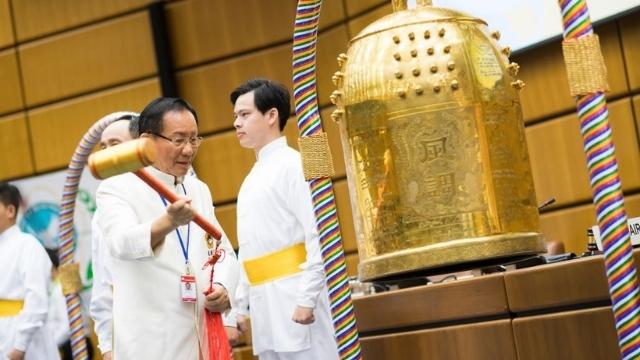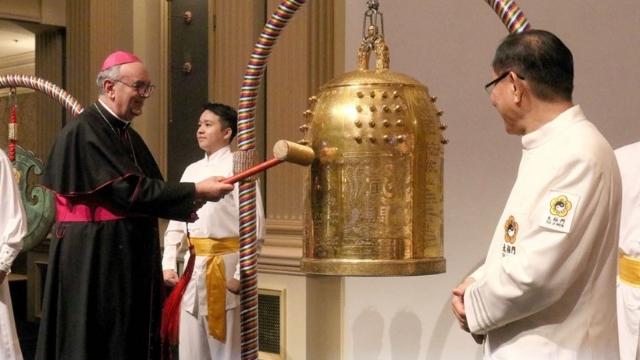The Tai Ji Men Bell of World Peace and Love has been rang by dignitaries of all religions, but it also has a meaning rooted in a millenarian Chinese tradition.
by PierLuigi Zoccatelli
*A paper presented at the webinar “Living Together in Peace with Tai Ji Men,” co-organized by CESNUR and Human Rights Without Frontiers on May 16, 2022, United Nations International Day of Living Together in Peace.

In 2002, I presented at the yearly international conference of CESNUR, the Center for Studies on New Religions, which was held in Salt Lake City and Provo, Utah, a paper on what I called the “esoteric paradigm.” Later, I returned to this concept in several articles.
I suggested that “esoteric paradigm” may be a general category, with clear differences from the “religious paradigm,” encompassing the very diverse movements and phenomena scholars discuss under the broad term “esotericism.”
In re-reading that paper today, I notice that all my examples were taken from Western esotericism. Indeed, there are chairs, reviews, and even an international association of scholars that include in their names “Western Esotericism.” However, in recent years, “Western esotericism” is becoming a contested label. Some maintains it has the advantage of identifying a tradition scholars have now studied and circumscribed for decades. Others regard the label as ethnocentric, and claim there are no reasons to regard esotericism as a specifically Western phenomenon, since there are esoteric currents in the traditions of Asia and other continents as well.

We will certainly not solve this debate today. However, I would like to suggest that Tai Ji Men’s unique approach to the theme of peace is also part of what I called “esoteric paradigm.” Perhaps this may help exploring the extensions of the paradigm beyond the West.
On September 21, 1999, a devastating earthquake hit Taiwan. Four days thereafter, on September 25, Tai Ji Men held the event “Love of the World: A Gathering for World Peace” at Taipei Municipal Stadium. The event had been planned beforehand, but the earthquake gave to the audience, which included government officials, academics, and leaders of different religions, a sense of urgency.
The leader of Tai Ji Men, Dr. Hong Tao-Tze, developed the idea of the Bell of World Peace and Love long before the event. He clearly indicated that the bell carries a special meaning in both Western and Eastern traditions. He said that, “The sounds of the bell in western churches and in eastern temples reminds people to listen to their inner voice. The sound of the bell represents people’s true hearts, social harmony, a nation’s success. and world peace.”

Hundreds of world leaders, including presidents, prime ministers, UN ambassadors, religious authorities, NGO leaders have rung Tai Ji Men’s Bell during Dr. Hong’s world tours. While it can be appreciated just as a beautiful message of love, for the Tai Ji Men dizi (disciples) it has a deeper meaning, which is in fact esoteric.
At the core of Tai Ji Men worldview is the idea that a harmony between yin and yang, heaven and earth, heart and qi (energy), was part of the original purity of human beings. It was since lost, but it can be restored, together with peace. Ringing the Bell is part of a movement restoring the world and humanity to its original purity.
Although dizi are members of several different religions, Tai Ji Men is rooted in the tradition of esoteric Taoism. In this tradition, and indeed in many others, sacred objects may function as catalysts of unseen energies, and determine effects going well beyond what non-initiated may see or predict. Sacred sounds, in turn, may generate powerful waves of energy.
The Bell of Peace is much more than a secular symbol of good will. It is a sacred artifact, each component of which has a precise esoteric meaning. The five petals of the emblem on the logo represent the five continents of the world —and the five elements in space of the Taoist tradition: wood, fire, earth, metal, and water. On top of the bell, there is a crystal ball, whose interaction with the gold of the bell manifests the equilibrium of yin and yang.
At the top of the bell, the eight elements (bagua) of the Chinese classic “I Ching” are represented. They are the eight components of the universe created by the original interaction of yin and yang. On the body of the bell, different auspicious creatures that have a precise meaning in the Chinese esoteric traditions are represented: the mythical one-horned “qilin,” lions, phoenixes, and dragons, the latter represented chasing a pearl.

The Bell of World Peace and Love is a microcosm, and according to Tai Ji Men has a mysterious but real correspondence with the macrocosm of the universe. That they know it or not, dizi believe that those who ring the Bell enter into a powerful energetic current whose roots are in a millenarian Chinese tradition, for which the Bell, as an esoteric artifact and a sacred object, serves as a catalyst.
On the one hand, Tai Ji Men’s approach to a world of peace and love is part of an “esoteric paradigm.” On the other hand, ringing the Bell is part of what in another webinar of this series has been called an effective “citizen diplomacy,” which achieves demonstrable results in a secular sphere. Several international politicians reported that ringing the Bell inspired them to effectively work for peace.
That Tai Ji Men, praised not only by international but also by Taiwanese politicians and chiefs of state for its commitment to world peace, is persecuted and harassed through taxes in Taiwan is a paradox difficult to understand. But this point is discussed by other speakers in this webinar.
Source: Bitter Winter

